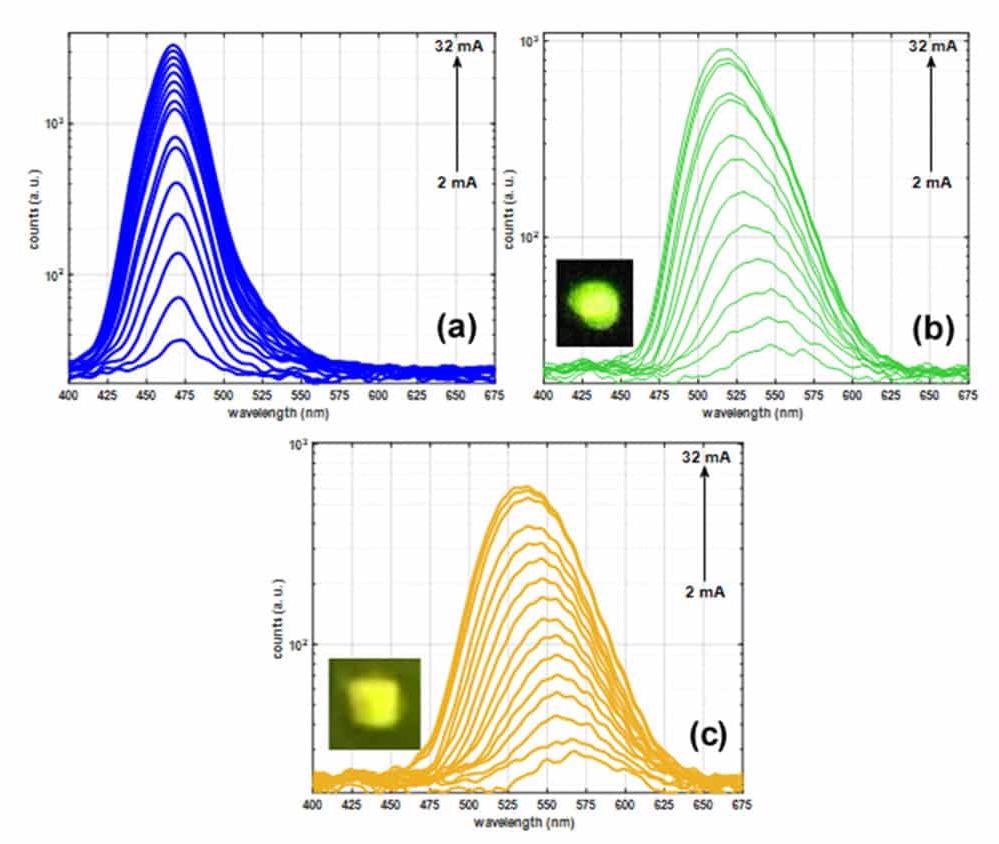A new process by scientists from North Carolina State University (NC State) exploits the current industry-standard techniques for producing III-nitride semiconductor materials but results in layered materials that can upgrade the efficiency levels of lasers and LEDs.
 Electroluminescence measurements of (a) Blue LED on GaN, (b) Green LED on InGaN template, (c) Near yellow LED on InGaN template. The insets of Fig. 1(b) and Fig. 1(c) show the image of the emission at 1.5 mA injection current. Image Credit: North Carolina State University.
Electroluminescence measurements of (a) Blue LED on GaN, (b) Green LED on InGaN template, (c) Near yellow LED on InGaN template. The insets of Fig. 1(b) and Fig. 1(c) show the image of the emission at 1.5 mA injection current. Image Credit: North Carolina State University.
Wide-bandgap semiconductors such as III-nitride semiconductor materials are of specific interest in photonic and optic applications because they can be used to make LEDs and lasers that create light in the visible bandwidth range.
Concerning mass manufacturing, III-nitride semiconductor materials can be produced using a method known as metal-organic chemical vapor deposition (MOCVD).
Semiconductor equipment needs two materials, a “p-type” and an “n-type.” Electrons travel from the n-type material to the p-type material, which is rendered possible by developing a p-type material that contains “holes,” or spaces that electrons can travel into.
A difficulty faced by those who manufacture lasers and LEDs has been that there was a restriction on the number of holes that could be made in p-type III-nitride semiconductor material that was produced using MOCVD. However, that restriction recently increased.
We have developed a process that produces the highest concentration of holes in p-type material in any III-Nitride semiconductor made using MOCVD. And this is high quality material—very few defects—making it suitable for use in a variety of devices.
Salah Bedair, Study Co-Author and Distinguished Professor of Electrical and Computer Engineering, NC State
In real-world terms, this translates as more of the energy input in LEDs is turned into light. For lasers, it translates as less of the energy input will be wasted as heat by decreasing the metal contact resistance.
LEDs comprise three key layers: an n-type layer where electrons are created; the so-called “active region,” which comprises numerous quantum wells of indium gallium nitride and gallium nitride; and a p-type layer, where the holes are created.
To make semiconductor materials for use in laser diodes or LEDs, the NC State team used a growth technique called “semibulk growth” to create indium gallium nitride templates. The template is composed of dozens of layers of gallium nitride and indium gallium nitride.
The scientists employ these templates for the n-type region to minimize complications that occur due to the growth of the quantum wells. Forcing the gallium nitride layer in between the indium gallium nitride layers in semibulk decreases imperfections because of the lattice mismatch between the semibulk template and the gallium nitride substrate, as well as filling the pits that develop on the surface.
In their new study, the team showed that the semibulk growth method can be applied for the p-type layer in LEDs to boost the number of holes. This new method is economical from a manufacturing viewpoint since III-nitride based LED devices can be made in one growth via MOCVD, without an extensive processing time in between.
Using this method, the scientists could accomplish a hole density of 5 × 1019 cm-3 in the p-type material. Formerly, the highest hole concentration realized in p-type III-nitride materials using MOCVD was approximately an order of magnitude lower.
These indium gallium nitride templates were also used by the team as substrates for LED structures to resolve a long-standing issue known as the “green gap,” where the LED output weakens when discharging in the green and yellow parts of the spectrum.
One of the key reasons for the green gap is the large lattice disparity between the light-emitting part of the material and the quantum well when gallium nitride substrates are employed. The scientists have shown that swapping the gallium nitride substrates with indium gallium nitride templates results in better LED performances.
The team compared the LED emission spectrum for the same quantum well discharging in blue when grown on gallium nitride substrate and producing either in green or yellow when grown on various indium gallium nitride templates. A 100 nm modification in the emission wavelength was accomplished because of the application of the indium gallium nitride templates.
The article on enhanced efficiency, “P-type InxGa1-xN semibulk templates (0.02 < x < 0.16) with room temperature hole concentration of mid-1019 cm-3 and device quality surface morphology,” has been reported in the journal Applied Physics Letters.
The first two authors of the article are Evyn Routh and Mostafa Abdelhamid, who are both PhD students at NC State. The article was co-authored by Peter Colter, a postdoctoral researcher at NC State and by Nadia El-Masry of the National Science Foundation and NC State.
The article describing addressing the green gap in LEDs has been published in Superlattices and Microstructures titled, “Shifting LED emission from blue to the green gap spectral range using In0.12Ga0.88N relaxed templates.”
The first two authors of the article are Routh and Abdelhamid. The article was co-authored by Ahmed Shaker, a visiting scientist at NC State from EinShams University in Egypt.
Journal References:
- Routh, E.L., et al. (2021) P-type InxGa1-xN semibulk templates (0.02 < x < 0.16) with room temperature hole concentration of mid-1019 cm-3 and device quality surface morphology. Applied Physics Letters. doi.org/10.1063/5.0065194.
- Abdelhamid, M., et al. (2021) Shifting LED emission from blue to the green gap spectral range using In0.12Ga0.88N relaxed templates. Superlattices and Microstructures. doi.org/10.1016/j.spmi.2021.107065.